
Rogerley Mine
×
Home

The Rogerley quarry and mine are located just west of the village of Frosterley in County Durham, on the north side of the A689 road to Stanhope. The old limestone quarry at Rogerley was initially investigated in 1972 by Lindsay Greenbank and Michael “Mick” Sutcliffe where they discovered two mineralised veins. These were named in their honour as the Greenbank and Sutcliffe veins, the former being named by Sir Kingsley Dunham, then Professor Emeritus of Geology at the University of Durham and director of the British Geological Survey.


Rogerley became the first commercial mineral specimen mine in Britain and for the past 47 years it has been worked on and off for its magnificent green fluorite. The Fluorite is also famous for its wonderful daylight fluorescence which causes the emerald-green crystals to glow an intense and vibrant purple. Fluorite does not naturally fluoresce, and it is the presence of rare earth elements at Weardale which determine this property.


For almost twenty years Rogerley was mined during the summer months by the U.S.A. based dealers and collectors Cal Graeber and Jessie Fisher. In 2017 ownership passed to Ian and Diana Bruce under the company name UK Mining Ventures Limited.
Of all the magnificent Weardale Fluorite specimens produced over the past two hundred years, the Rogerley mine now ranks as having produced probably the best quality specimens and continues to do so. Some of the most perfect and magnificent coloured specimens seen in the world’s top natural history museums and private collections are from Rogerley and no good British collection is complete without at least one!
Records of mining in the Weardale area date back to the 12th century, chiefly for iron and lead, but also zinc, copper, silver and barium. Limestone was an important commodity as a flux in iron and steel making and in more recent times the vast fluorite deposits have been exploited for this same purpose. Towards the east, the ore field overlaps the Durham coalfield, hence the historic growth of the iron and steel industries in this area, synonymous with smelting towns such as Consett.
The original Rogerley Quarry (Figure 4) was operated during the mid-19th century for limestone, an essential resource in the late period of the Industrial Revolution as a flux for iron making in the nearby foundries of Tow Law and Consett. Just when the quarry closed is uncertain, but it certainly remained derelict for many years.

During the 1960s and 70s, mineral collecting in Britain was becoming a popular interest and Weardale was a productive hunting ground because of its numerous mines and much sought-after specimens. Inevitably, collectors found their way to the spoil heaps and quarry floor at Rogerley where attractive specimens of green fluorite were quickly unearthed.
The first documented mineral collector to find specimen grade fluorite in the Rogerley quarry was Raymond Blackburn around 1970. He recognised that the source of these specimens as a small zone high on the quarry's north face, but not being keen on heights, chose not to climb or descend to the required zone. Raymond Blackburn sold some of the specimens to the well-known Kendal-based collectors Lindsay and Patricia Greenbank.
Armed with Raymond Blackburn's description of the likely source in the quarry face, the Greenbanks first visited the site in 1971. Existing specimens from their initial finds from the quarry floor show sharp cubic crystals to 20mm of a mid-sea to peppermint green with cloudy white centres, associated with small, partly etched, octahedral and cuboctahedral galena crystals (Figure 5). Together with friends and collecting partners Michael (Mick) and Brenda Sutcliffe, the face exposure was investigated using electron ladders lowered from the top of the quarry (Fisher, 2003). Cavities were found in the face near the top of the Great Limestone, a major stratigraphic unit in this area. Mineralisation occurred associated with a North-South trending vein and horizontal flats emanating from the vein, later named the Greenbank vein by Sir Kingsley Dunham, then Professor Emeritus of Geology at the University of Durham and director of the British Geological Survey.


Specimen mining began at Rogerley in 1972 and from this point on the mine has been in almost continuous operation for specimen recovery. Table 1 summarises the specimen recovery operations of the Rogerley quarry and mine.
| Period | Operating Company & Summary of Operations |
|---|---|
| 1972 to 1996 |
Cumbria Mining and Mineral Company (CMMC) Lindsay and Patricia Greenbank with Michael and Brenda Sutcliffe. The first specimen mining project ever undertaken in the British Isles. Necessary leases to the mineral rights for the quarry were obtained from the land agents acting on behalf of the Church Commissioners of England whereas public access and trespass rights were negotiated with the then land owner. The specimen recovery operation was run mainly on a "weekend only" basis for close to 25 years. |
| 1999 to 2016 |
UK Mining Ventures LLC (UKMV, LLC) A small team of American collectors and mineral dealers. Full time Summer season specimen mining began in May 1999 and ran every subsequent year until 2016. Almost all the mine development was made during this period, together with most of the, now famous, named fluorite pockets (see Table 5). |
| 2017 onwards |
UK Mining Ventures Limited (UKMV Ltd.) Ian and Diana Bruce. Start of new mine development to follow-up an extensive geological investigation including surface and underground geological mapping and a laser imaging survey of all existing mine workings. Development of the outcrop of the Sutcliffe Vein in the western face of Rogerley quarry commenced in summer 2017 with the discovery of a 6 x 10m richly mineralised fluorite cavity. This section, named the Diana Maria mine, is characterised by a substrate of iron stained colourless quartz crystals covered with colour-zoned purple and green cubic fluorite crystals. The fluorite is commonly associated with druzy overgrowths of creamy-white aragonite. |
Lindsay and Patricia Greenbank are well known British mineral collectors and dealers, based in Kendal, Cumbria, in the English Lake District. During the 1960s the Greenbanks began buying specimens from miners at the Groverake and Blackdene mines in Weardale, a 1.5-hour drive from Kendal. This was initially to enhance their own collection, but due to the prolific supply of top grade specimens, this led to them taking specimens to trade while on holiday in Europe, so marking the beginning of their move into commercial dealing. Patricia had been Lindsay's collecting partner and they were married in 1973 (Wilson, 2017). The Lindsay Greenbank mineral collection was first documented in Michael "Mick" Cooper's Classic Minerals of Northern England - The Lindsay Greenbank Collection (Bevins et al., 2010) limited to fifty copies, in 1996. However, in 2010 the collection became known to the widespread mineral community when an expanded version of Copper's book was published in the Mineralogical Record special issue dedicated to his Northern England collection (Wilson, 2010).
Michael "Mick" and Brenda Sutcliffe were mineral collectors also living in Kendal and had already become friends with Patricia and Lindsay. Mick originally grew-up in Blyth, Northumberland, and became interested in Northern England minerals after moving to Kendal while still a young man. In 1972, the Greenbanks and Sutcliffes jointly formed the Cumbria Mining and Mineral Company (CMMC) to recover mineral specimens form the known, but unworked veins at Rogerley quarry in County Durham. In 1982, Lindsay and Mick together with business partners Peter Blezard and Anne Danson formed the New Coledale Mining Company, Ltd. to operate the Force Crag mine near Keswick in the English Lake District, finally closing in 1990 due to a major collapse and build-up of water.
In 1996 Lindsay became very ill (Fisher, 2003 and Wilson, 2017), so ending mining operations and in 1998 it was decided to sell the mine; at this point a 35-metre-long adit (Moore, 2016). The Rogerley project was bought by a small group of American collectors and dealers, under the consortium name UK Mining Ventures LLC, with operations commencing in the summer of 1999.
The initial work was to make ready the mine following many years of relative neglect and unauthorised entry by collectors to high-grade. Due to the somewhat high rainfall in Northern England, the mine workings tend to be very wet and so clay is transported into the workings, thereby masking the walls and working faces. Once this was removed using power washers, promising mineralised zones were quickly identified and so began an annual summer collecting season which was to run for eighteen years.
The many significant finds are described later, but of note was a large find of some 1,800 specimens in summer 1999; beautiful coloured fluorites from the West Cross Cut in 2001 and 2003 that sold at the St. Marie-aux-Mines show and those specimens from the Jewel Box and Rat Hole pockets which sold at the 2007 Denver show (Moore, 2016). The most famous specimen recovered by UKMV LCC was that of the Weardale Giant in 2012 (Ralph and Ralph, 2012). This was shown at the 2013 Tucson Gem and Mineral Show, but was subsequently reduced in size to make many smaller specimens.
Following almost twenty years of frequent transatlantic crossings, busy schedules and increasing operational challenges the partners of UKMV LLC decided to sell on the mining rights to a new operator and so the current phase of mining began.
Ian and Diana Bruce are internationally known mineral dealers having formed Crystal Classics Fine Minerals in 1993. Ian grew-up in Devonshire (Southwood, 2016), becoming interested in minerals at an early age. Between graduating from Cardiff University in Mining Geology and starting Crystal Classics Fine Minerals, he collected full time in Cornwall and then Australia for eighteen months. Following its closure in 1998, he was pivotal in driving a specimen recovery project at the world famous Tsumeb mine in Namibia, forming the Tsumeb Specimen Mining (Pty) Ltd with Simon Brock and David Lloyd. By 2001, Tsumeb was back in operation as a specimen mine, but for only a short while due to insurmountable technical problems. The mineral Ianbruceite is named for him, whose type locality is on 44 level in the Tsumeb mine. Ian's wife Diana is from an old Saxony family of mineral collectors and dealers. In 2017, they formed the company UK Mining Ventures Limited, to continue specimen mining at Rogerley (Figure 6).

This subsurface plan of Rogerley mine shows every major named mineralised pocket discovered since the late 1990s when underground operations began. It shows the spatial distribution and varied mineralogy along the Greenbank Vein, so allowing collectors to pinpoint where their specimens originated.
This section is a repository for photographs and associated information taken since mining operations began in 1999, documenting mineral discoveries and development of the Rogerley mine.
Three photographic archives contain a wide selection of photos which will be added to whenever new material is appears.
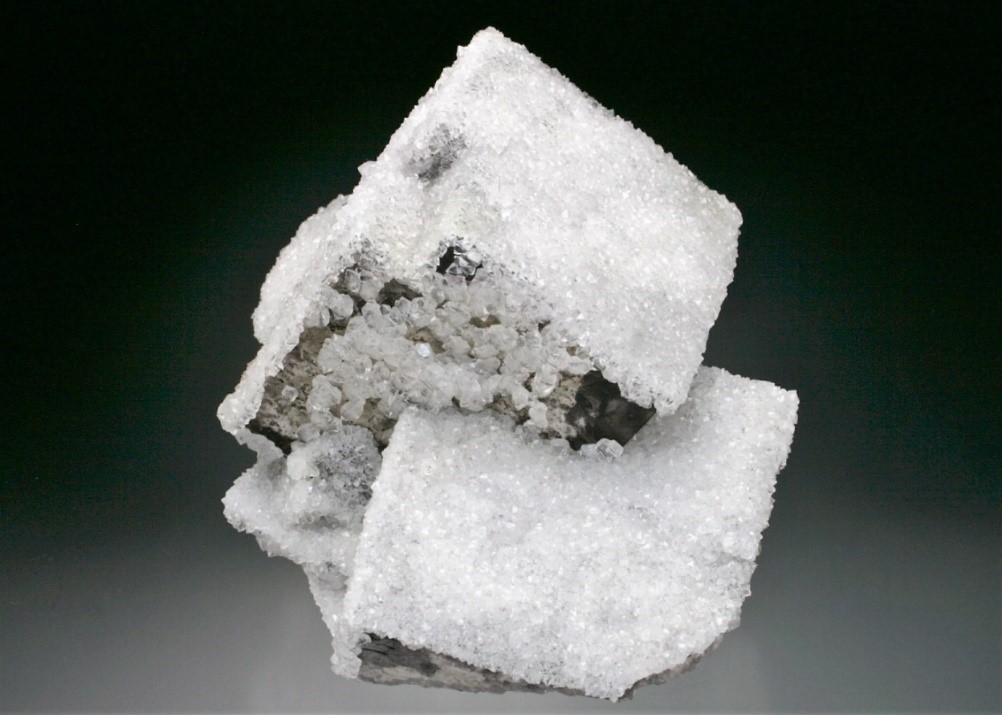
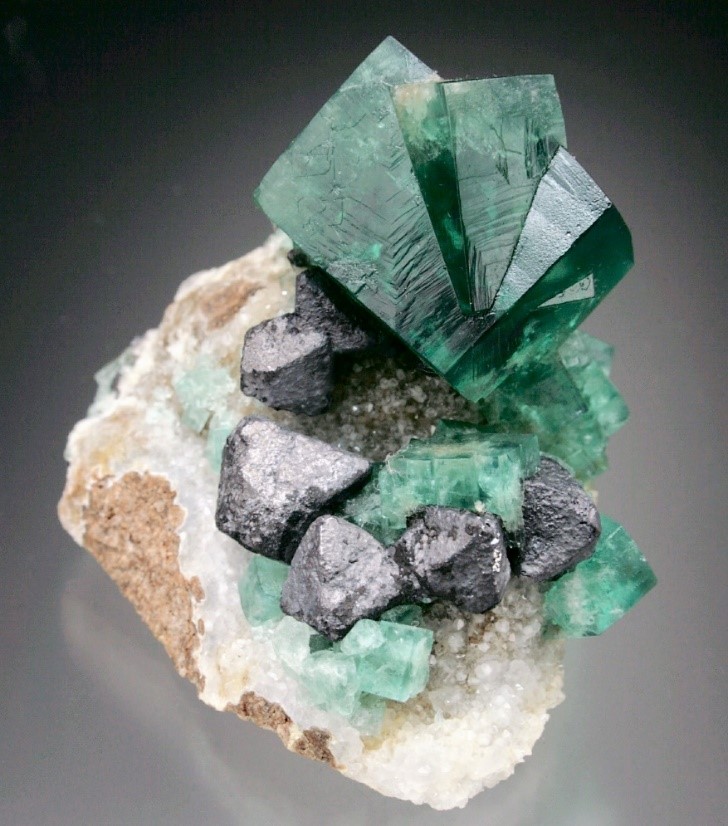
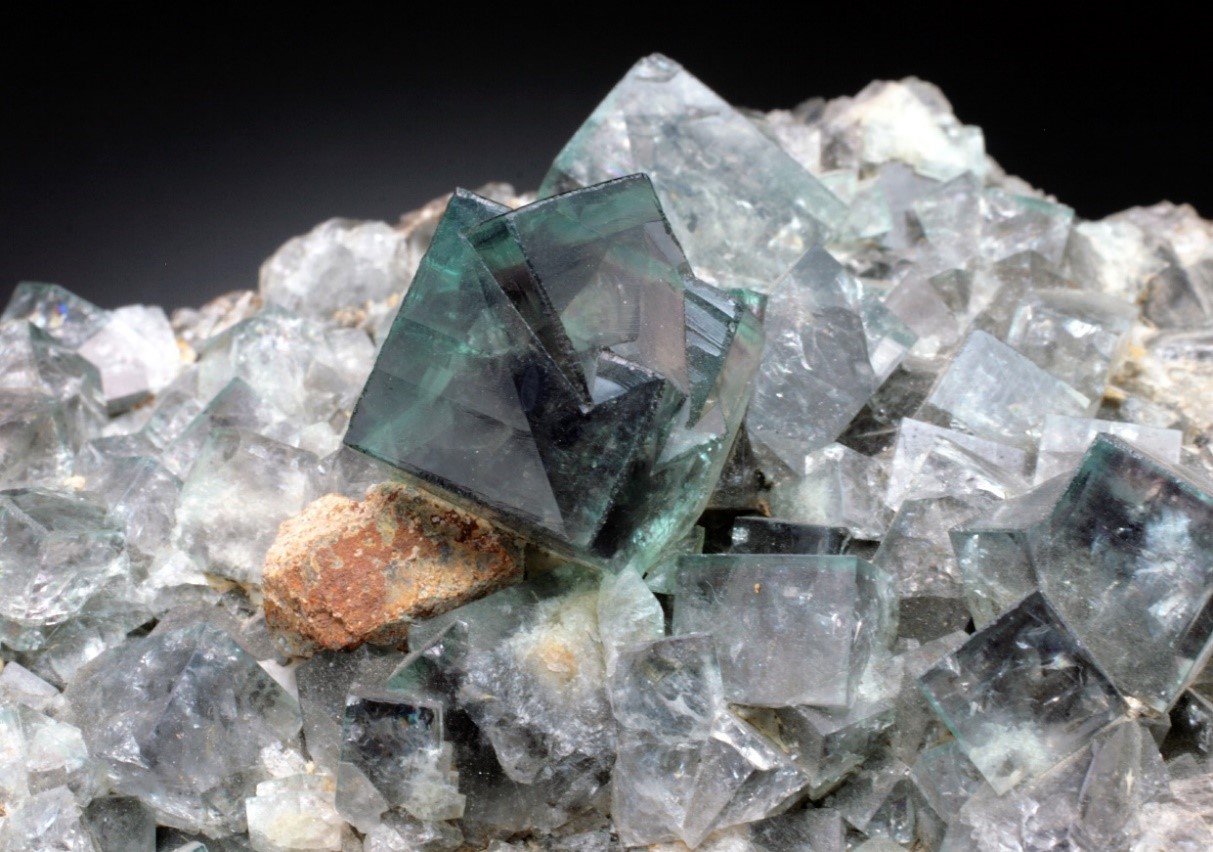
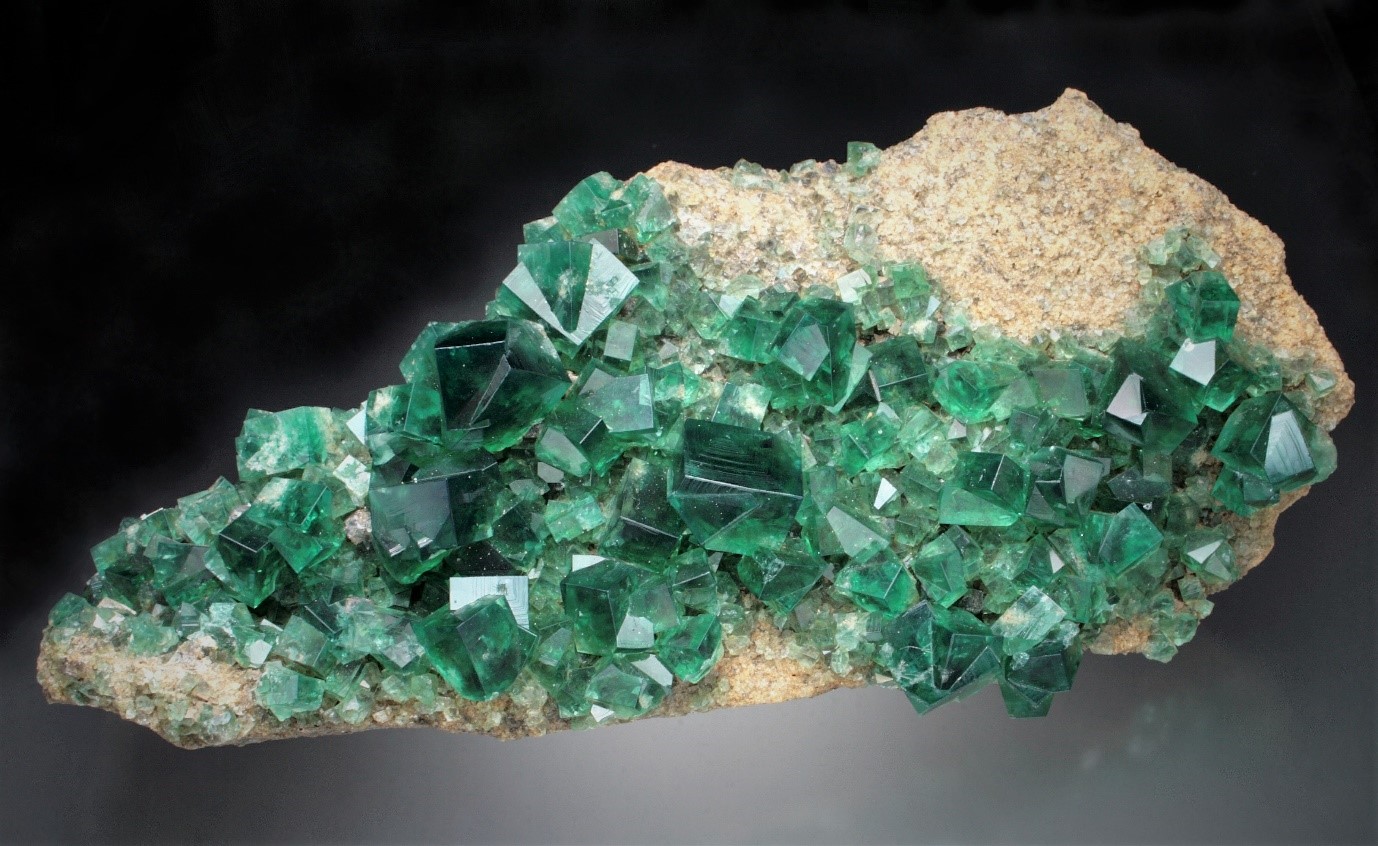
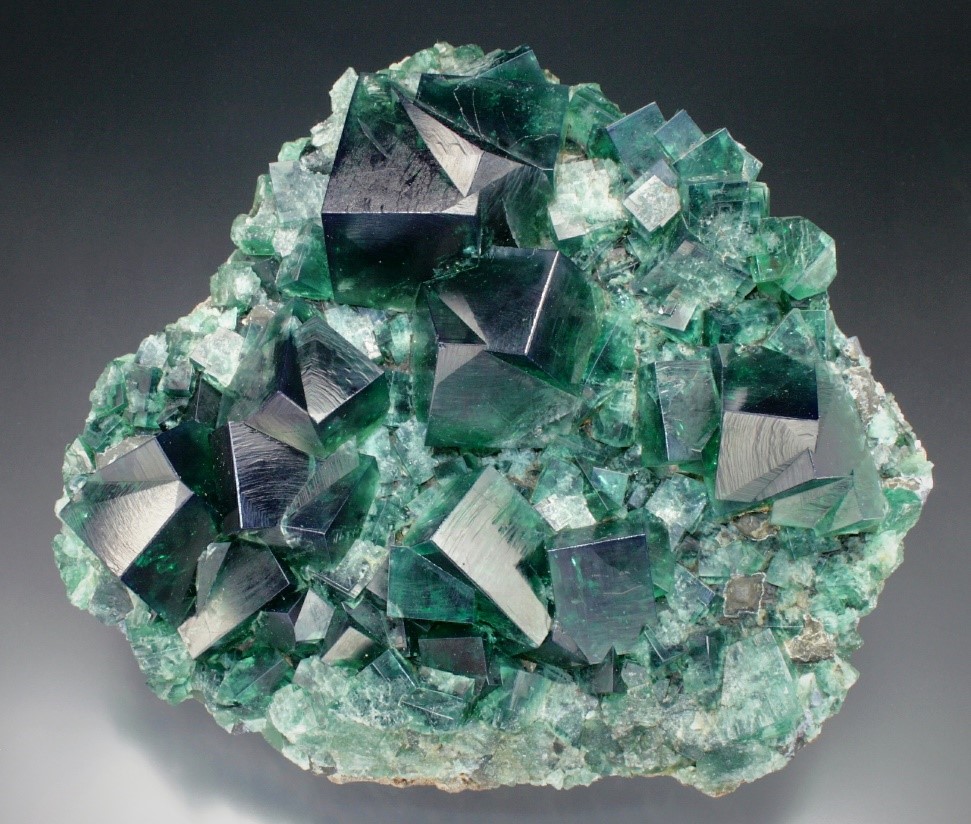
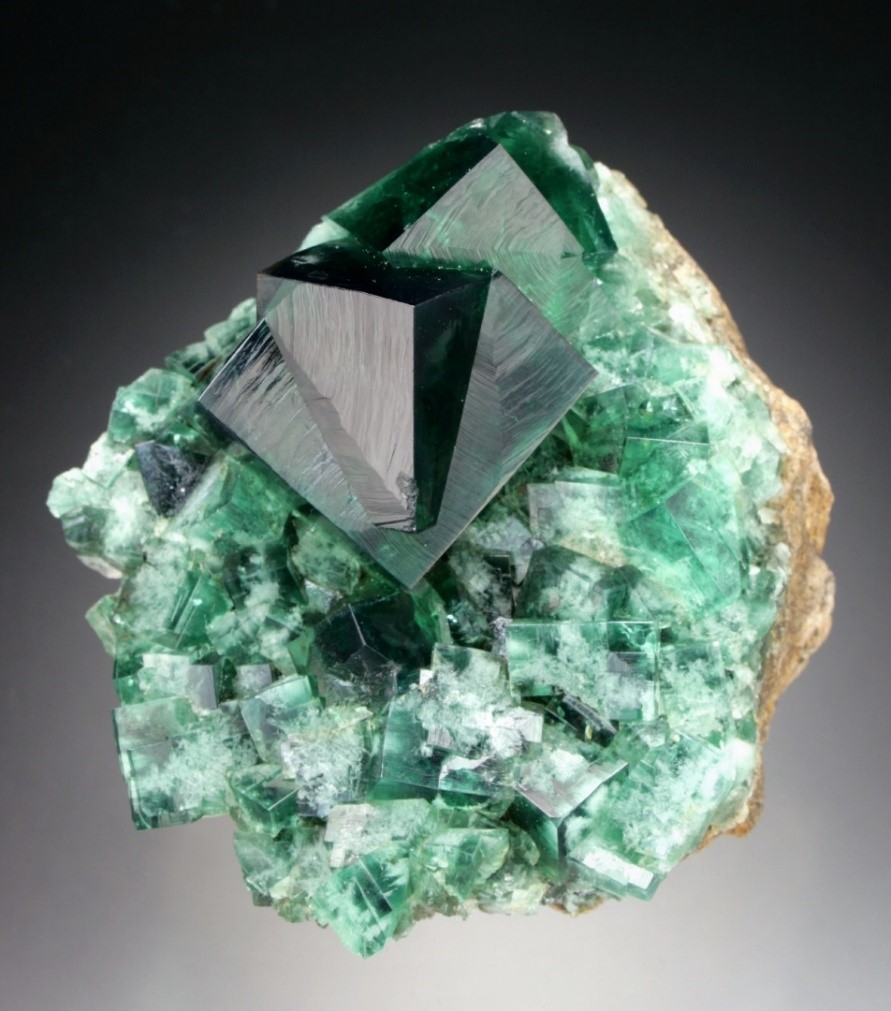
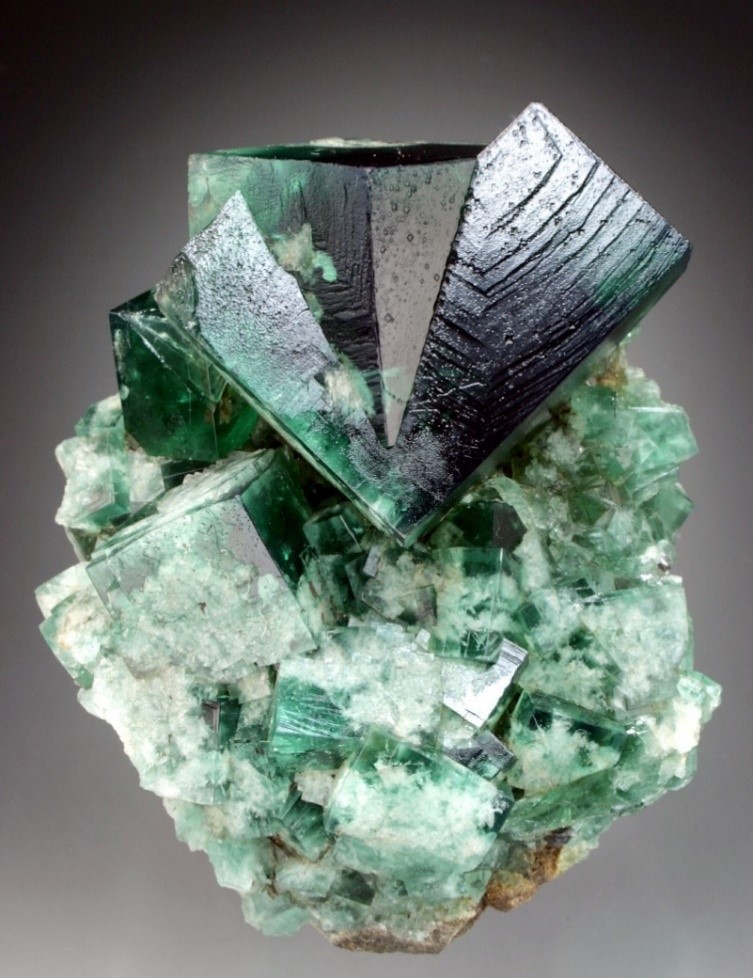
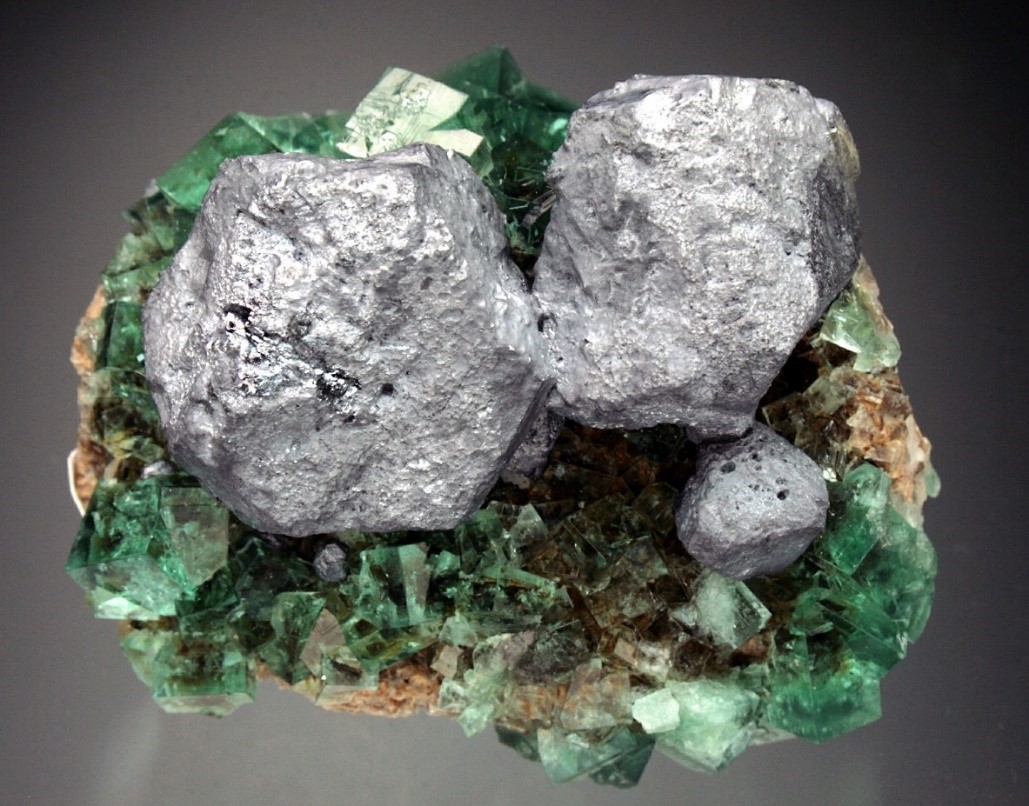
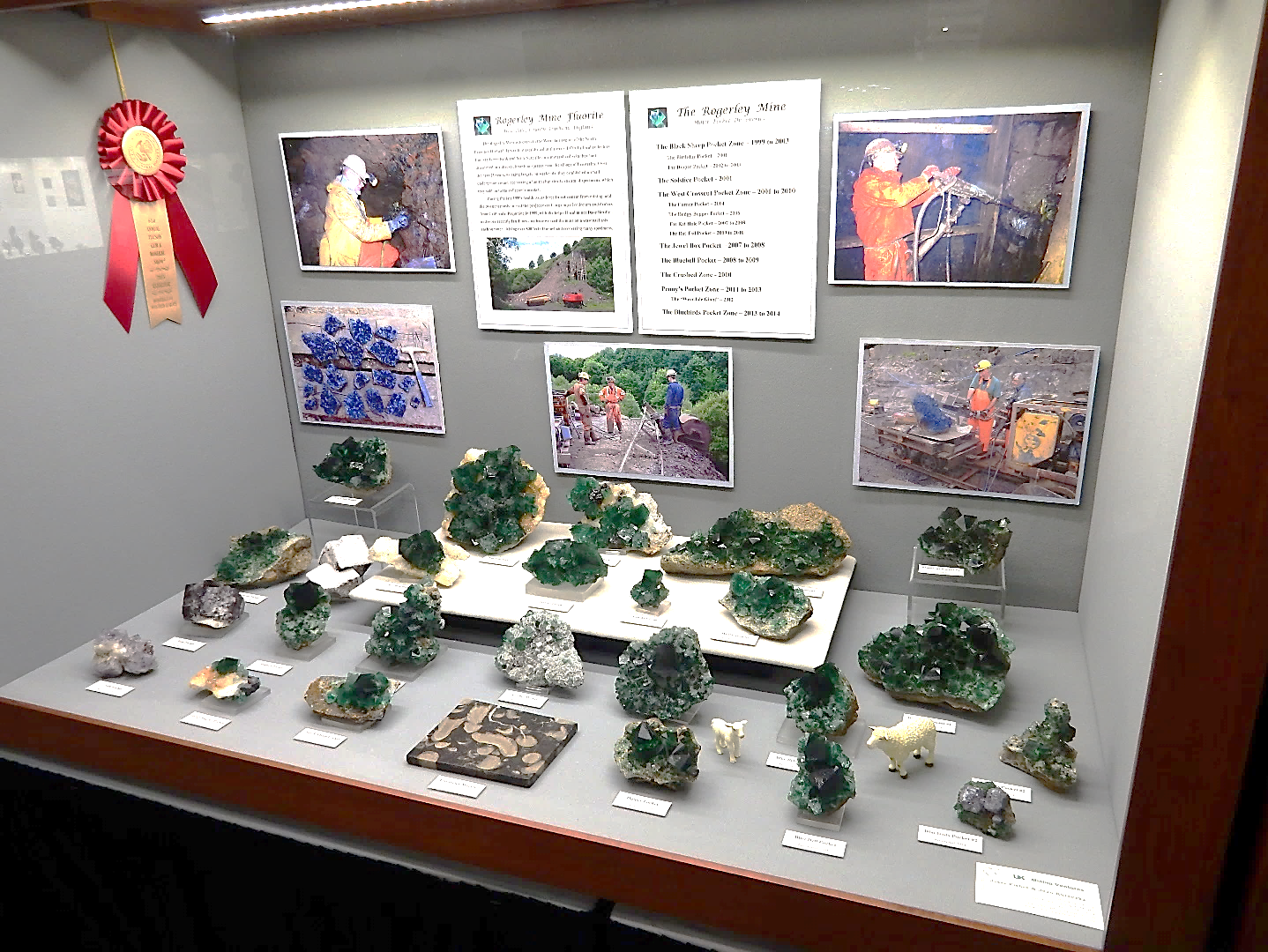
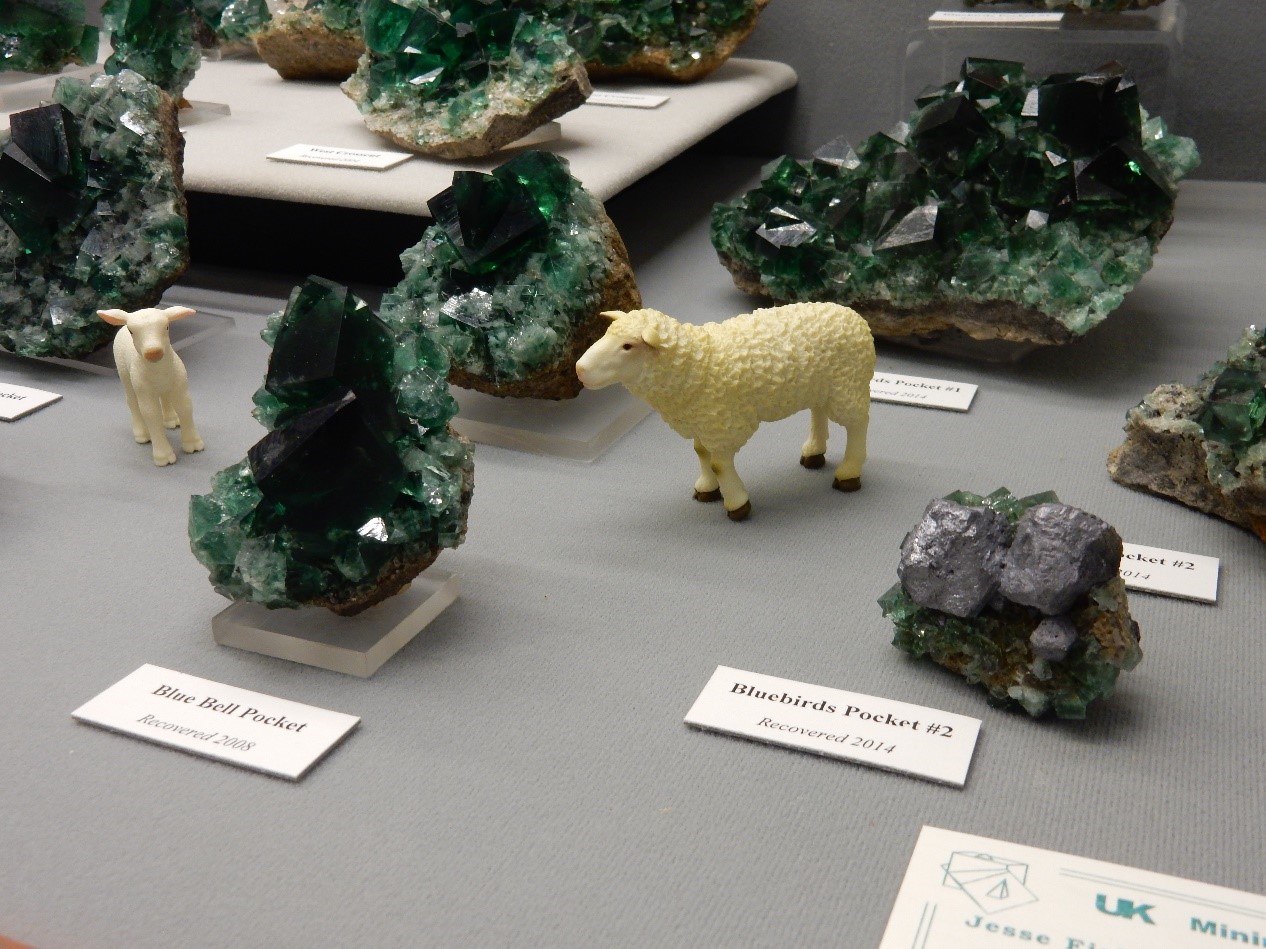
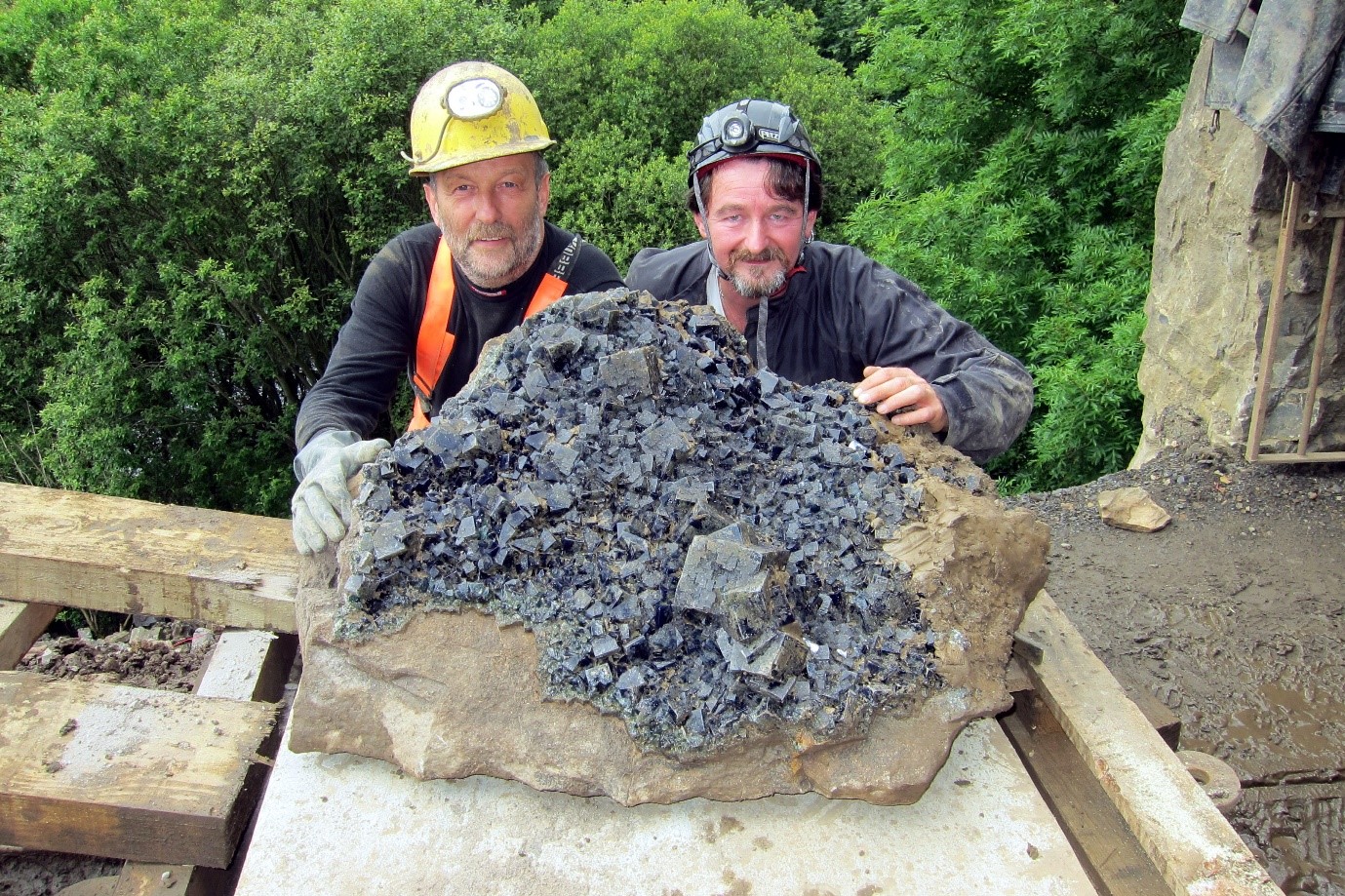

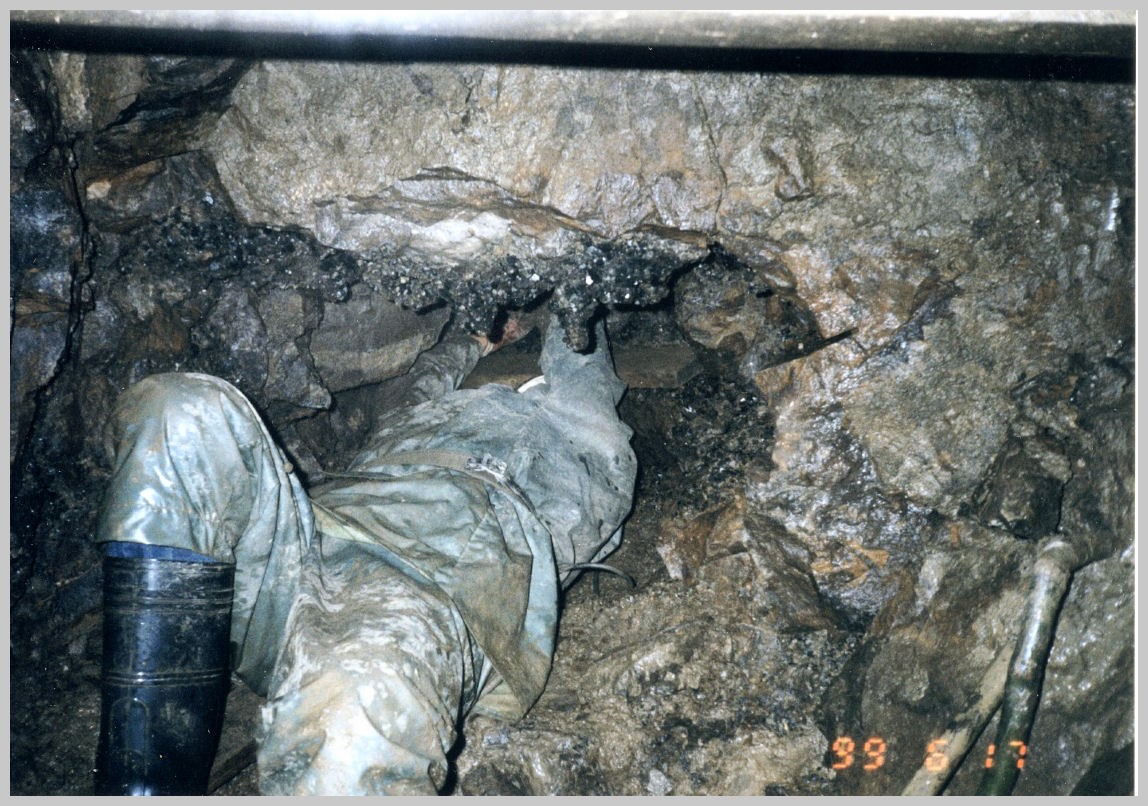
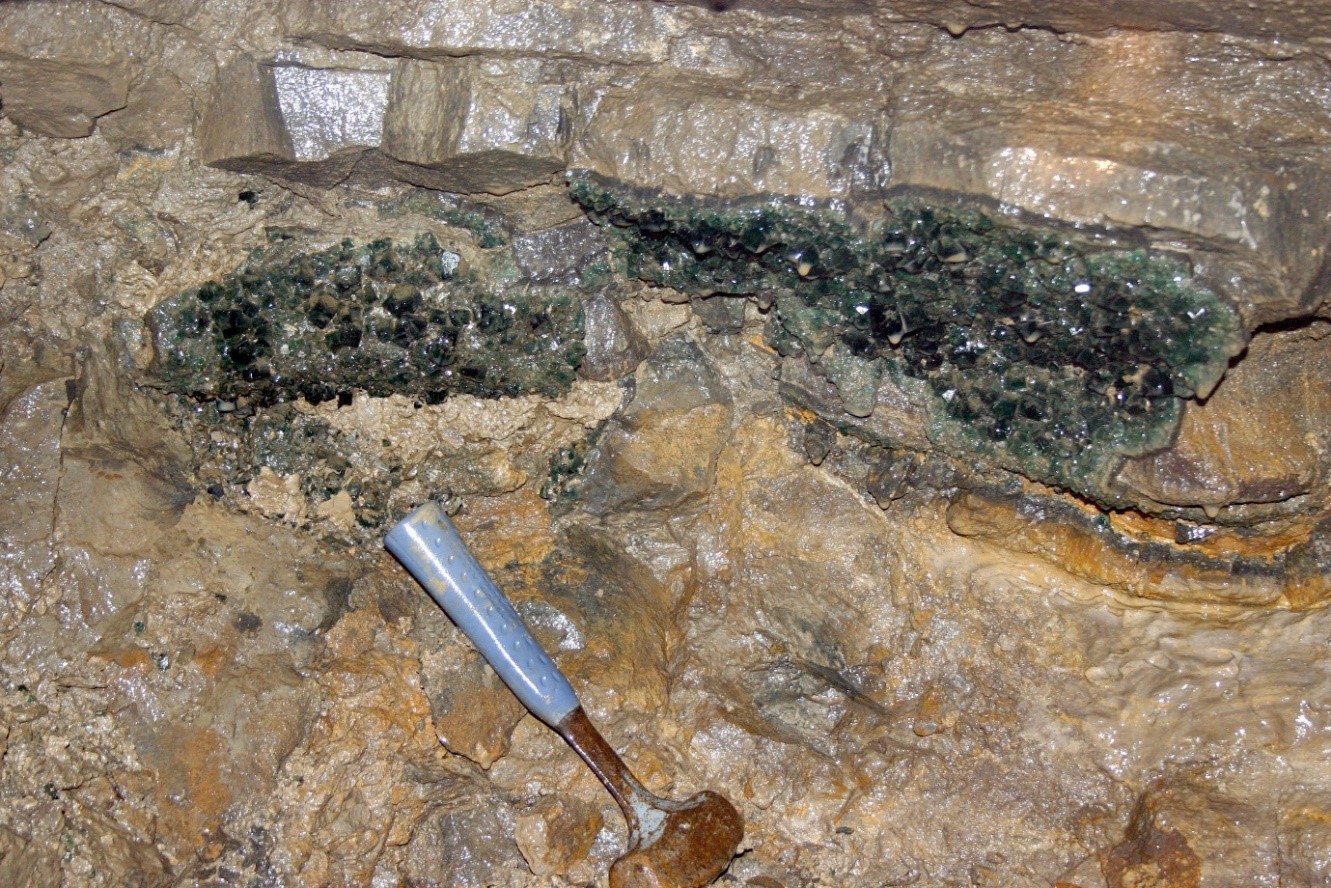
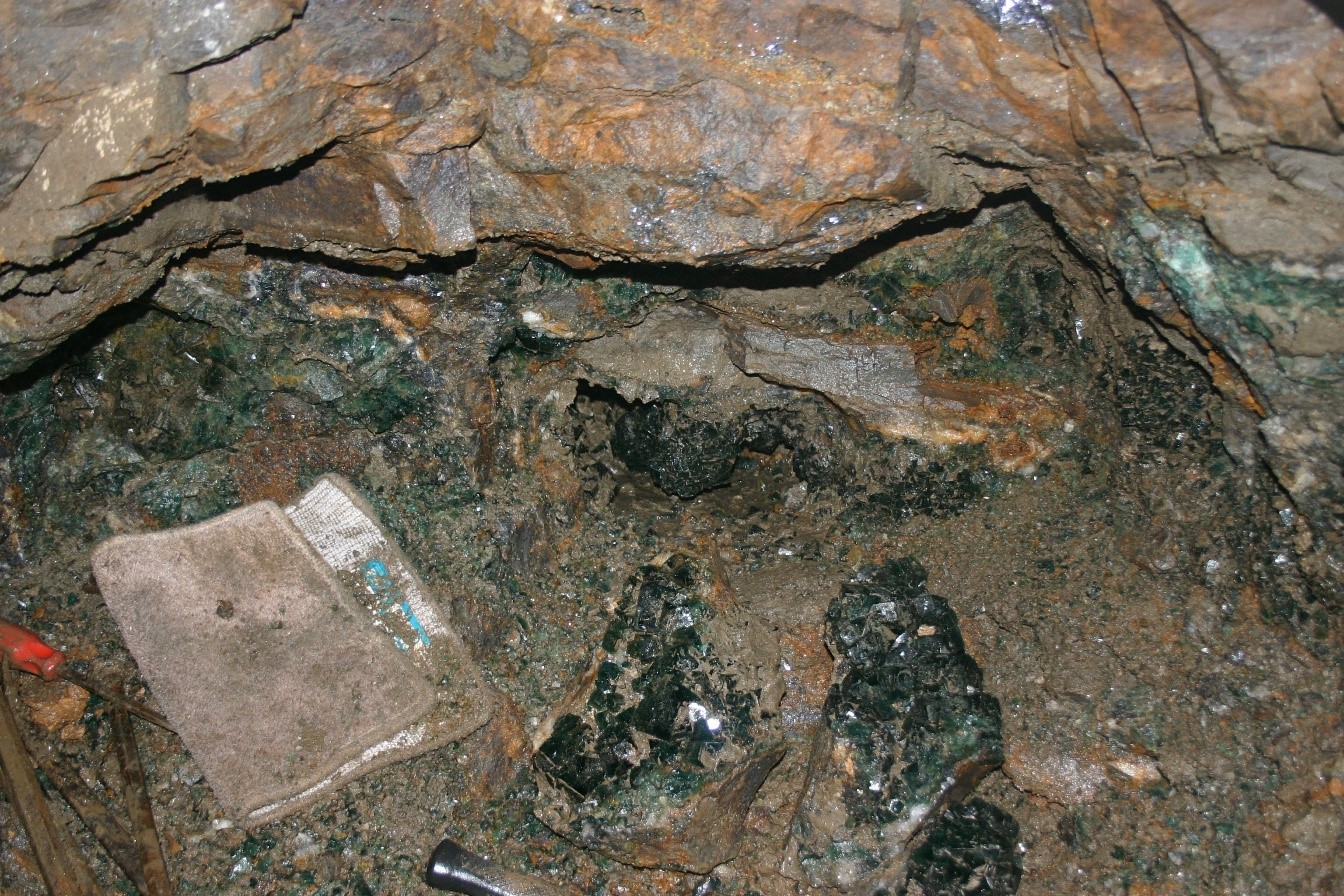

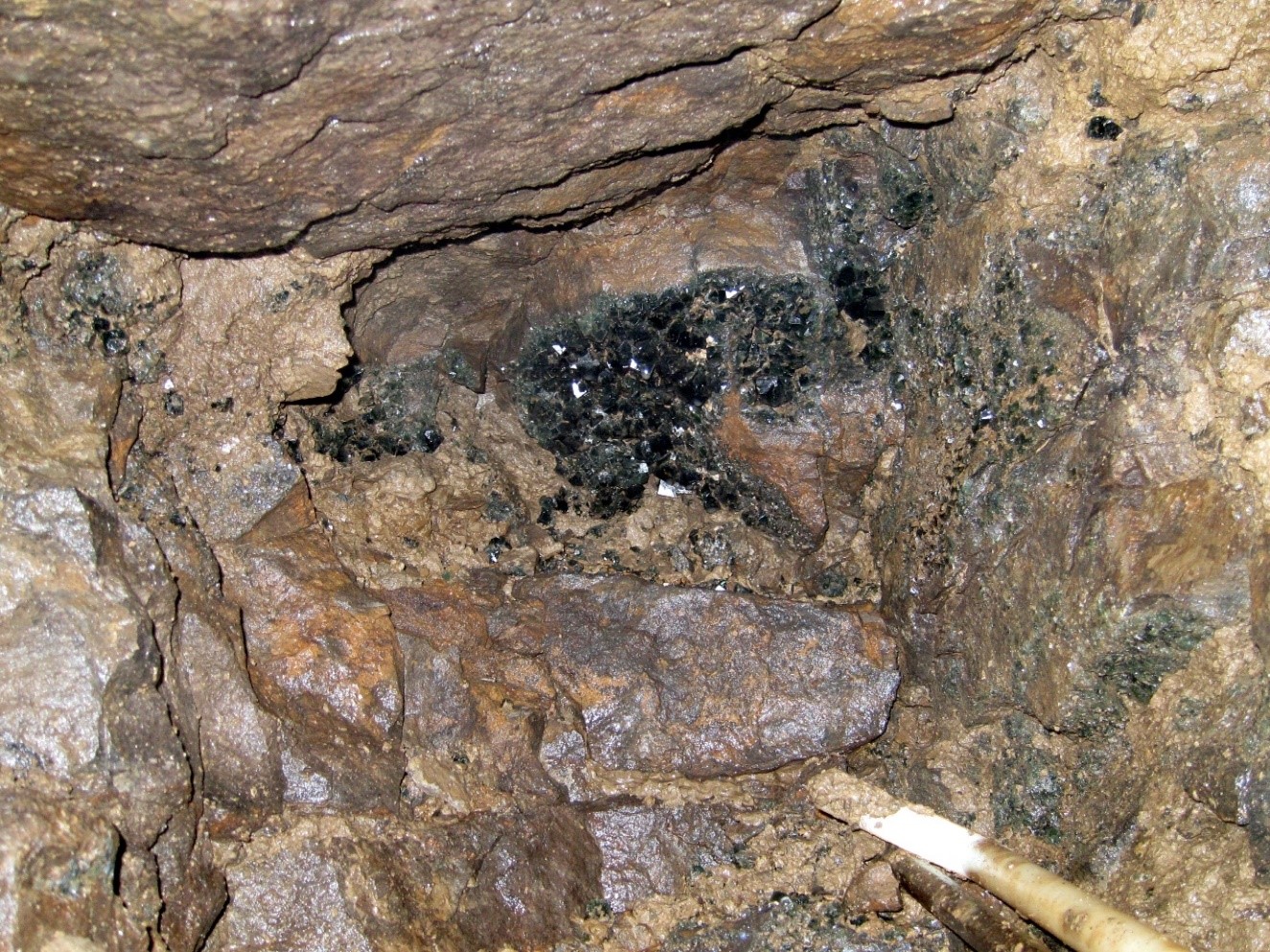
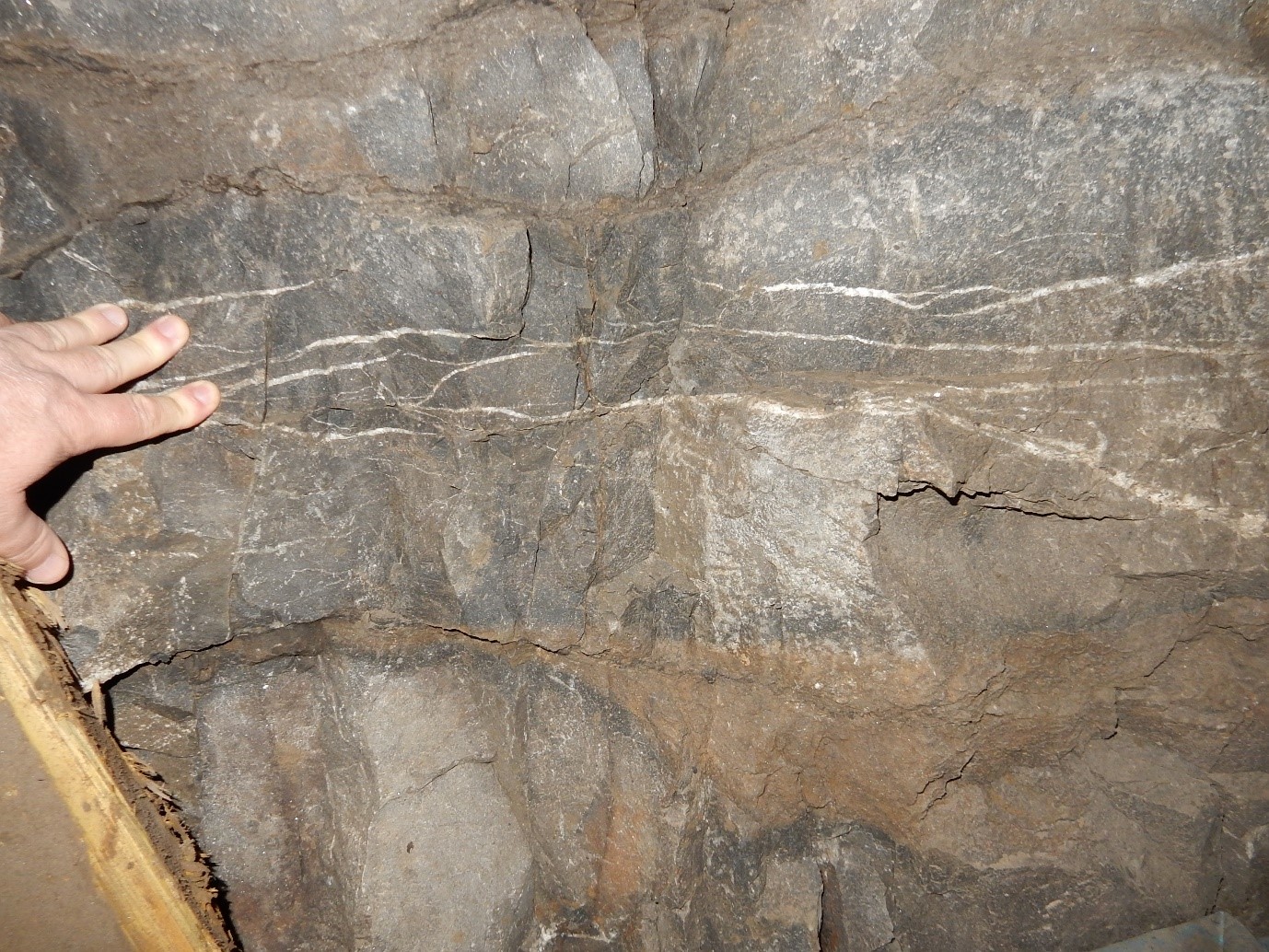
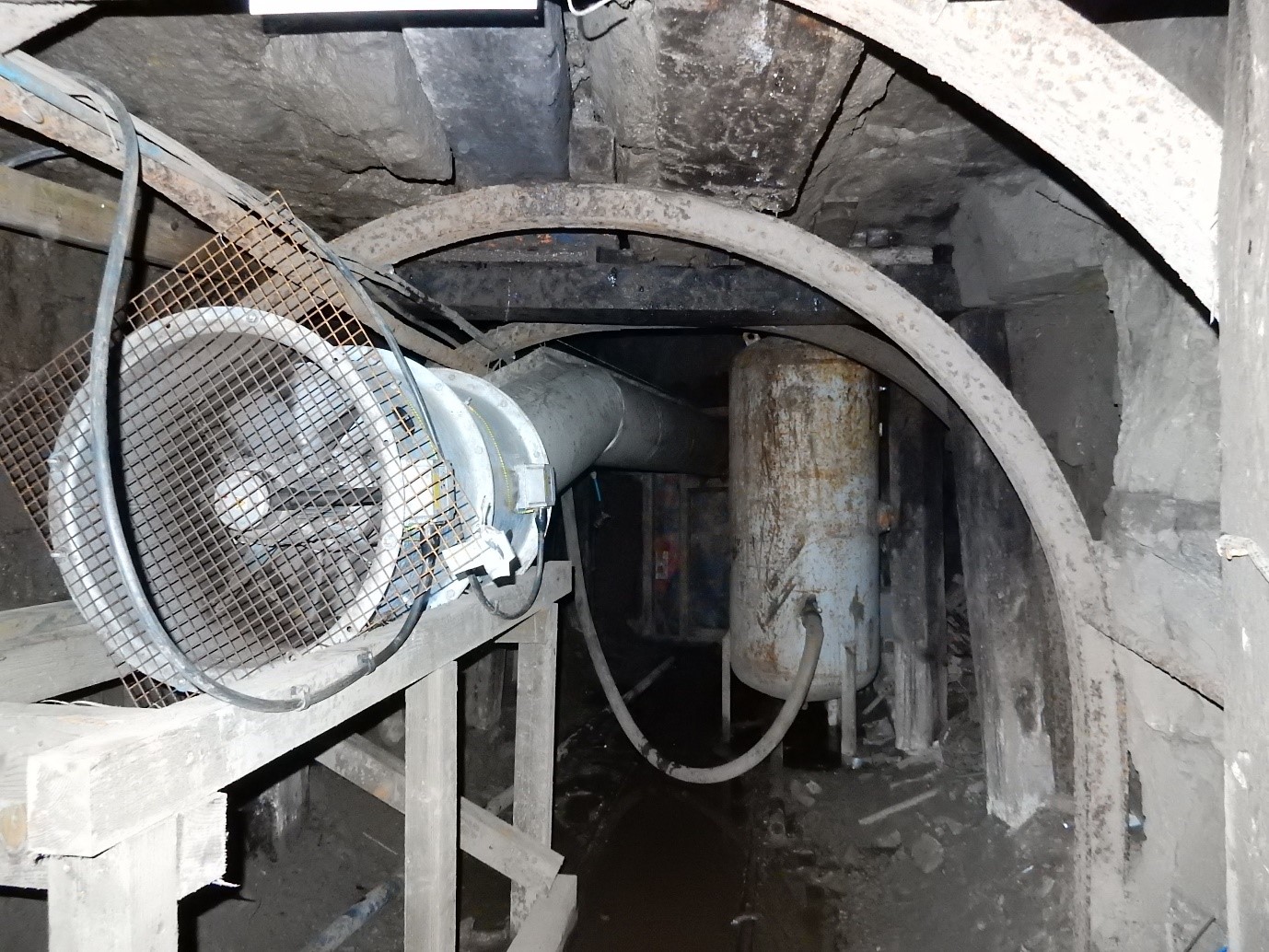
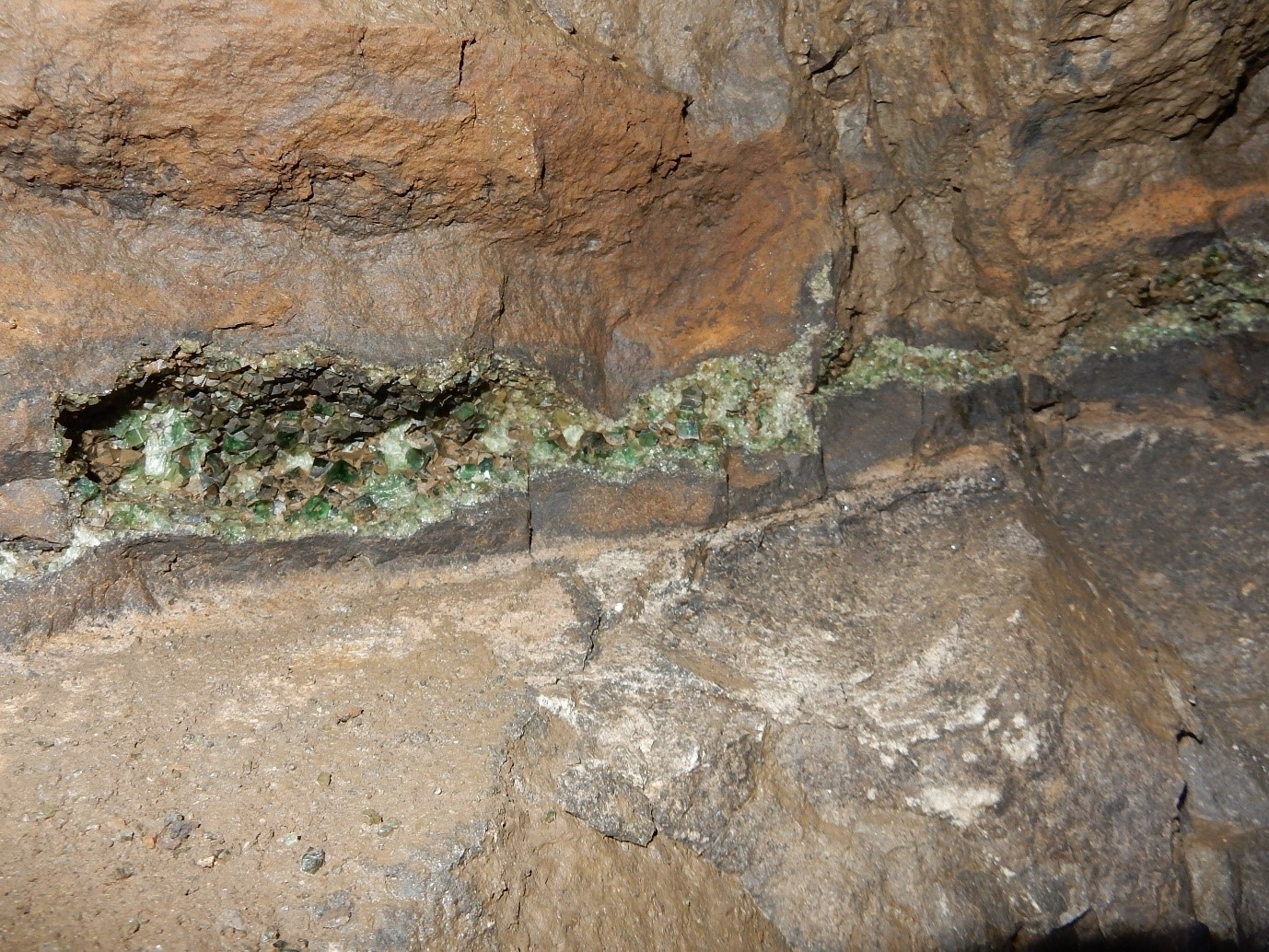
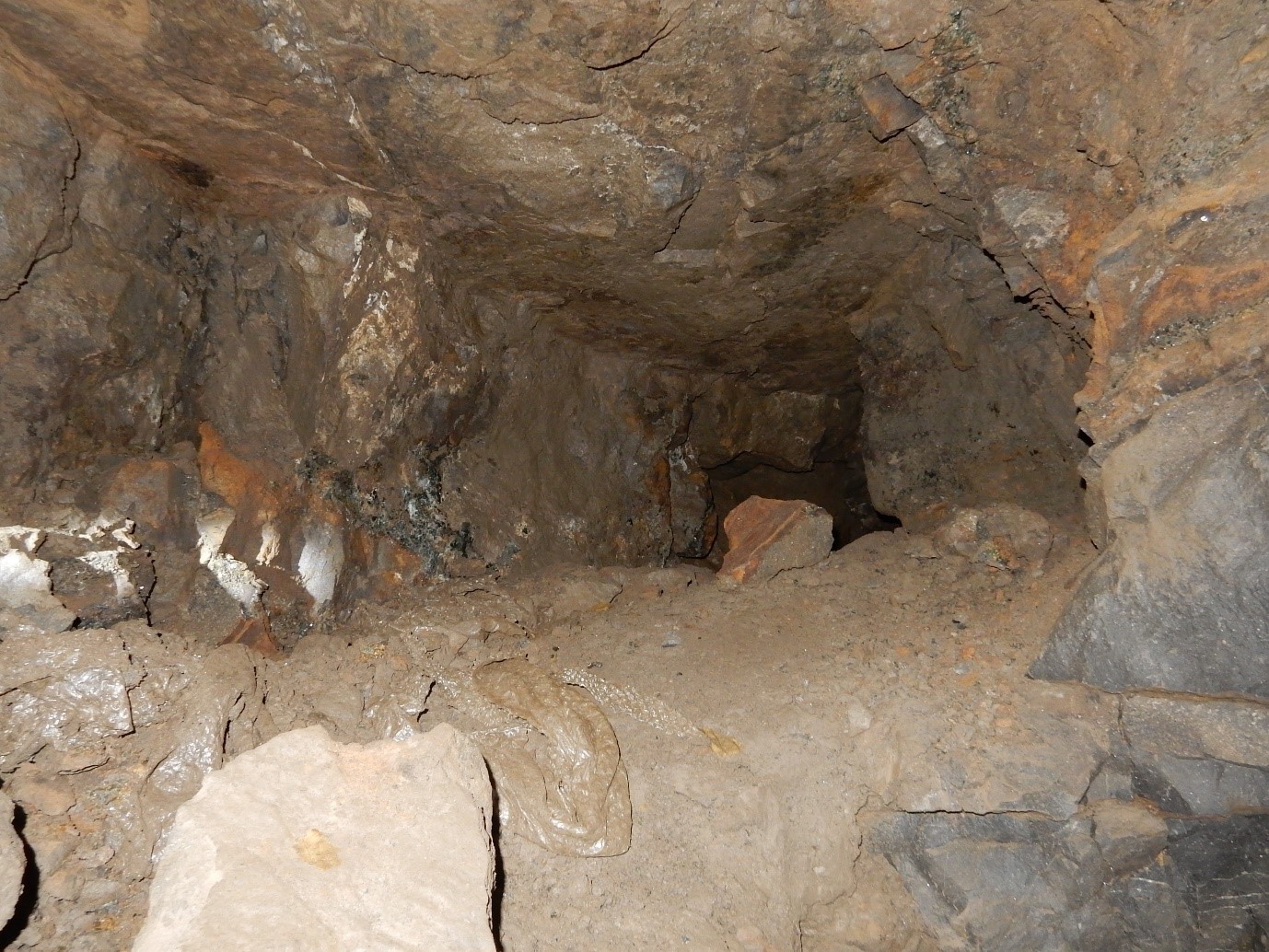
The structural geology and mineralisation at the Rogerley mine is a microcosm of that at the regional scale. Beneath Fatherley Hill, west of Frosterley, a near-vertical mineralised vein forms the central mineralising conduit of the deposit, within the upper unit of the Great Limestone.
Mineralised veins form within active faults. These contain rubblised (brecciated) zones of high porosity and permeability and allow vertical fluid flow between horizontal beds of much lower permeability. Changes in temperature, pressure, flow rate and flow direction, together with chemical reactivity with fault wall rock and rubble, have resulted in the precipitation and growth of fluorite crystals. The vuggy porosity provided within the brecciated fault zone provided the accommodation space in which crystals of fluorite and galena could fully develop; these are termed euhedral crystals and for which Rogerley mine is now famous for. Other minerals present, but to a much lesser extent, are aragonite, calcite, hydrocerussite, quartz and smithsonite (Fisher and Greenbank, 2003; Symes and Young, 2008; Tindle, 2008 & Wilson, 2017).
Around the sub-vertical vein system, metasomatic, horizontal mineralisation (flats) extends laterally; subparallel to the limestone country rock bedding. A good example of this process was observed in the West Cross Cut. The limestone country rock shows extensive replacement by iron carbonate minerals (ankerite and siderite). Since deposition, these have oxidised through exposure to oxygen-rich groundwater and form a heavily iron-stained gossan-like matrix over which the fluorite has crystallised.
Figure 1 is an idealised sketch to illustrate some of the structural and mineralisation processes present at Rogerley. The diagram shows a mineralised normal fault in a currently active state, thereby acting as a fluid conduit. In this case, the term active does not imply movement is still occurring on the fault, but that the horizontal stress orientation is favourable to fluid flow. Other faults trending at around 90° to this would have remained "closed", acting as permeability barriers. Radial fractures emanating from the fault system penetrate the limestone parallel to bedding and so allow the mineralising fluids to extend horizontally through the country rock. Other processes are noted in the diagram, such as permeability controls to fluid flow and colour distribution in fluorite.

A relatively small number of mineral species have been found in Rogerley quarry and mine and are listed in Table 2 together with their chemical composition. It is apparent from Table 2 that there is also a limited number of elements present (C, Ca, F, Fe, H, Mg, O, Pb, S and Zn) and these reflect the chemistry of the host rocks (mainly carbonates) and transported metals and halide (Fe, Pb, Mg, Zn and F).
| Mineral Species | Chemical Formula | Word-formula |
|---|---|---|
| Ankerite | Ca(Fe, Mg)(CO3)2 | Calcium iron magnesium carbonate |
| Aragonite | CaCO3 | Calcium carbonate |
| Calcite | CaCO3 | Calcium carbonate |
| Dolomite | CaMg(CO3)2 | Calcium magnesium carbonate |
| Fluorite | CaF2 | Calcium fluoride |
| Galena | PbS | Lead sulphide |
| Hydrocerussite | Pb3(CO3)2(OH)2 | Lead carbonate |
| Quartz | SiO2 | Silicon oxide |
| Siderite | FeCO3 | Iron carbonate |
| Smithsonite | ZnCO3 | Zinc carbonate |
From the collector's perspective, it is interesting to note that hydrothermal veins often contain larger (up to 8 cm on edge), single, fluorite crystals (i.e. untwinned), often of a more opaque, deep purple colour (Fig. 2). Green (Fig. 3) and yellow fluorite is also found in the veins, but to a lesser extent. The fluorite usually occurs with cuboctahedral and octahedral crystals of corroded galena. The matrix of vein specimens is hard, dense ironstone, following replacement by iron-rich solutions. Extracting specimens from these structures is difficult due to the rock's hardness and the pockets being generally smaller than those found in the replacement pockets.
Fluorite crystals recovered from the metasomatic flats are typically smaller (Fig. 4), various shades of emerald-green and frequently twinned on the octahedral {111} plane (Fig. 5). These are the famous penetration twins, also termed interpenetrant twins, for which many Weardale mines are famous.

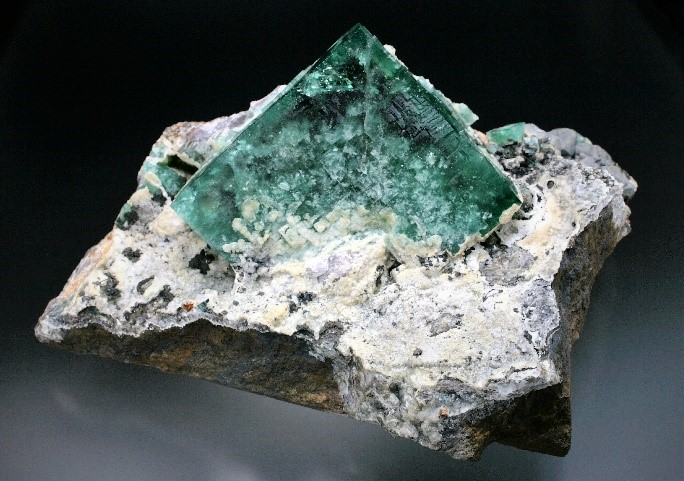
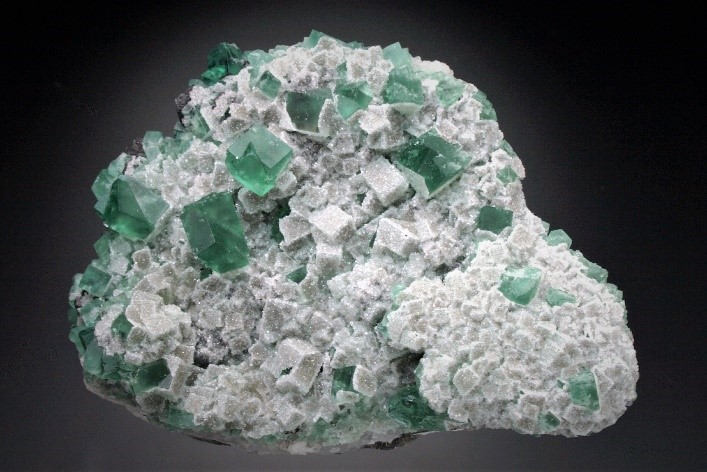

The cause of vivid colour in fluorite at Rogerley and other Weardale localities is still not clearly understood. However, through modern analytical techniques and observation of colour change in specimens, it is believed green results from structural defects in the fluorite lattice (Fisher and Greenbank, 2003). In the 1980s and 90s, rare earth elements (REEs) were considered a major cause of colour in Weardale fluorite, but this is now largely discredited. This is not the case for fluorescence in Weardale fluorite.
Since specimen recovery began in the 1970s by Greenbank and Sutcliffe; post-1999 by Graeber and Fisher and post 2017 by Ian Bruce, many collectors have built fine suites of Fluorite portraying the varying aesthetics of the different pockets and zones within the Rogerley mine. Two checklist tables follow:
The first table summarises the Rogerley mineralised pockets; their discovery date, pocket name and origin of the name.
The second table is an expansion of the former, containing more detailed information suitable to the advanced collector. Any notable specimens finds are also recorded in this checklist.
| Date/Period | Pocket or Zone | Origin of Pocket Name |
|---|---|---|
| 1999 to 2000 | Weasel pocket | For a stoat (mistaken for a weasel) who resided there. (Greenbank vein) |
| 1999 to 2000 | Black Sheep pocket | For a local ale, popular with the mining crew. |
| 2001 | Birthday pocket | For its discovery on one of the partners wife's birthdays. |
| 2001 to 2003 | Dipper pocket | For the mineralized flats which appeared to dip into the floor of the adit |
| 21st June 2001 | Solstice pocket | For discovery date on Mid-summer's day. |
| 2001 season end to summer 2003 | West Cross Cut | For a cross-cut driven opposite to the Black Sheep Pocket which encountered specimen grade Fluorite. |
| 2001 to 2010 | West Cross Cut pocket zone | For the location of a mineralised pocket off the West Crosscut. |
| 2003 to 2004 | Corner pocket | For its location at the northern edge of the West Crosscut zone. |
| 2006 | Dodgy Bugger pocket | Pocket named because most good specimens were on large, loose rocks in the roof, making collecting difficult and dangerous |
| 2007 to 2008 | Rat Hole pocket | For its long narrow shape and confined space, allowing only one person to collect at a time. |
| 8/2009 & 7/2010 | Rat Tail pocket | For an extension at one end of the Rat Hole Pocket. |
| 7/2007 to 2008 | Jewel Box pocket | For some of the finest specimens yet found in the mine. |
| 7/2008 & 6/2009 | Blue Bell pocket | For the favourite local pub, the Blue Bell Inn in St. Johns Chapel. |
| 2009 (late July) | High pocket | Because a ladder was needed to collect it. A small pocket of high quality. |
| 7/2010 | Purple pocket | For colour of contained fluorite. |
| 2010 | Crushed zone | For the brecciated texture within this deformation zone. |
| 2011 to end of June 2013 | Penny's pocket zone | For Penny Williamson, a visiting friend of the mining team and Curator of the Geological collection at the University of Wollongong, NSW, Australia. |
| 7/2012 | The Weardale Giant found in Penny's pocket zone. | For (due to its size) one of the three legendary Giants of Weardale. These were brothers who worked as blacksmiths on local surrounding hilltops. One single large specimen. |
| 2013 to 2014 | Bluebirds pocket zone No. 1 | Pocket named by team member Ian Jones in recognition of Cardiff City (nicknamed The Bluebirds) Football Club's promotion to the Premier League in 2013; the first time in its 144 years history. |
| 2014 to 2015 | The Bluebirds pocket zone No. 2 | For a continuation of the Bluebirds pocket zone as mining progressed east away from the vein. |
| January 2018 | Wolfie Pocket | For Wolfie, Ian and Diana Bruce's pet lurcher cross and chief Rock-hound! |
| November 2018 | Beadle Blast Pocket | For Dave Beadle, Mining Project Manager at Rogerley, who detonated the blast which revealed this pocket. |
Almost fifty years have now passed since the specimen potential of Rogerley quarry was first recognised. During this period, lots of wonderful discoveries have been made and readers will be aware of the many references describing many of these scattered throughout the literature and the internet. An attempt is made here to collate all such records of specimen finds, together with the specific mineralogical characteristics of individual veins and pockets. The advantage of web-based articles such as this is that updates can be made at will, as new information comes to light. Characterisation of the mineralogy of veins and pockets really needs to be done at the time of discovery, chiefly because of the very limited number of mineral species present in the mine and hence few significant differentiators. This is especially true in the case of collectable specimens which manly comprise of cubic green fluorite, cuboctahedral galena; sucrosic quart coatings and occasional calcite. Many zones within the veins and replacement flats do exhibit characteristic differences, but these are often subtle in terms of colour, morphology, texture, associations, matrix and fluorescence.
Some outstanding finds during Rogerley’s history include rare, blackberry-purple fluorite; other scarce purple and yellow fluorites associated with vein mineralisation; the Weardale Giant; pockets which exhibit exceptional daylight fluorescence and very rarely, fluorites covering Palaeozoic fossil corals such as Actinocyathus floriformis sp. When prepared into thin section mounts, such corals display the most delicate of structures at the microscopic scale (Fisher and Greenbank, 2003), so giving a clear indication of the piecemeal metasomatic replacement process which took place during flat-style mineralisation.
Based on a detailed study of the literature, internet articles, specimen descriptions and personal accounts, this second Checklist has been complied which also provides a record of mine development, structural geology and noteworthy events.
| Period/Date | Zone/Vein/Pocket | Mineralogy & Comments |
|---|---|---|
| Limestone quarrying period | ||
| Mid-19th century (actual operating period unknown) | Working limestone quarry | Opencast quarrying operation adjacent to, and north of the A689 Stanhope to Frosterley road. Limestone production. Minerals from the veins and flats were tipped in a waste dump. |
| Mineral Collectors period | ||
| Circa 1970-1972 | Spoil heap of mineral-rich "waste" and strewn limestone blocks in the quarry | Collector Raymond Blackburn is attributed (Fisher and Greenbank, 2003 & Wilson, 2010) with discovering specimen grade fluorite and galena, most likely in the old dump. Other collectors then got to know about the site and a period of specimen collecting from material strewn over the quarry floor commenced. |
| Cumbria Mining and Mineral Company (CMMC) | ||
| 1972 | Quarry floor and faces. Many faces were inaccessible. | Lindsay and Patricia Greenbank begin collecting and evaluating the quarry and enlist collecting friends Michael "Mick" and Brenda Sutcliffe as partners in the Cumbria Mining and Mineral Company (CMMC). |
| 1972 to 1975 | High Flats Horizon (Greenbank vein) | 10m long quarry bench, 20m above the quarry floor. |
| 1976 | Surface work (un-named Sutcliffe vein) | Good quality green and purple fluorite. The, yet unnamed, Sutcliffe vein on the top bench of the disused quarry. |
| Late 1970's | Greenbank vein | A cavity containing exceptional bright green fluorite was discovered near the surface directly below the previously cut bench level. Vein named by Sir Kingsley Dunham in recognition of Lindsay and Patricia Greenbank. |
| 1980 to 1995 | Mainly the Greenbank vein and adjacent, but unnamed pockets | All the specimens mined over this period were from the adit being driven along the Greenbank vein and adjacent flats. Specific pockets or exact localities within the mine are not documented, save for on the detailed labels usually accompanying the specimens (now in private collections). For reasons unknown, some specimens over this period were incorrectly attributed to the Eastgate quarry, also known as the Blue Circle Cement quarry (Wilson, 2010). Collation of data from old labels is currently ongoing. |
| 1996 | Final season of CMMC operations at Rogerley. Closure was necessary due to Lindsay Greenbank suffering the onset of ill health. | |
| UK Mining Ventures, LLC (UKMV) | ||
| 1999 to 2000 | Weasel pocket (Greenbank vein) | The largest vein pocket discovered to date which produced several large clusters of untwinned purple fluorite crystals, some coated with white finely crystalline drusy quartz. The fluorite crystals were opaque and slightly corroded, except around the edges (Fisher, 2003 & Moore, 2016).
Pocket named for a stoat (mistaken for a weasel) who resided there. |
| 1999 to 2001 | Black Sheep pocket | Interconnected series of fluorite-lined solution cavities in the flats to the east of the vein. Opened-up to a length of approximately 5 m, the wall rock surrounding these cavities was highly silicified. Zoned crystals found with green edges and inner blue or yellow cores and phantoms.
Pocket named for a local ale popular with the mining crew. |
| 2000 | Sutcliffe vein | A previously unrecognized mineral vein in the Rogerley Quarry was named the Sutcliffe Vein in recognition of Mick's contributions to the mining and specimen mineralogy of the area. |
| 2001 | Birthday pocket | After driving the new east adit through a highly brecciated zone, an area of flats to the northeast of the Black Sheep, now known as the "Birthday Pocket", was encountered. This area of flats produced some good, and often large plates covered with twinned green fluorite crystals, many showing patches of incipient alteration. Pocket named for its discovery on one of the partners wife's the birthday. |
| 2001 to 2003 | The Dipper pocket | Fairly-well brecciated, but only a small number of good-quality specimens recovered. Pocket named because the mineralized flats appeared to dip into the floor of the adit. |
| 21st June 2001 Mid-summer's day | Solstice pocket | A cavity in one of the flats was discovered along the main adit, about 10 meters north of the original Black Sheep Pocket opening. Specimens from this area, though not numerous, were of very high quality, showing good lustre or very little corrosion. Pocket named for discovery date. |
| 2001 end of season to summer 2003 | West Cross Cut | Started opposite the Black Sheep Pocket to see if flats existed to the west of the main vein as well as to the east. After a couple of blasts, green fluorite specimens were found here and this has proven to be the most productive area of flats yet found in the mine. The area around the West Crosscut has undergone extensive replacement by iron carbonates rather than silica. These have oxidized creating a heavily iron stained gossan-like matrix for the fluorite in much of the area. |
| 2001 to 2010 | West Cross Cut pocket zone | Extensive replacement by the iron carbonate minerals ankerite and siderite. Pocket named for its location within the mine. |
| 2003 to 2004 | The Corner pocket | Not large, but produced some unique specimens for Rogerley. Most of the fluorite crystals were small and a lightish-green colour, but had a late-stage coating of fine-grained sucrosic quartz. Pocket named for its location at the northern edge of the West Crosscut zone. |
| 2006 | The Tube | While driving an exploratory crosscut eastward from the main adit, a long, narrow, tube-like pocket was found. Much of the pocket was lined with massive galena, and several large, crudely formed cuboctahedral galena crystals were found. Several fluorite clusters of an unusual pale green colour with internal purple layers associated with quartz were also recovered from this pocket. Pocket named for its structure. |
| 2006 | The Dodgy Bugger pocket | Found on the southern area of the West Crosscut zone. Pocket named because most good specimens were on large, loose rocks in the roof, making collecting difficult and dangerous. |
| 2007 to 2008 | The Rat Hole pocket | Clusters of larger, untwinned fluorite crystals, often on a layer of white quartz. Galena, common elsewhere, was almost totally absent here. This pocket was a long, narrow tube, lined with fluorite and produced hundreds of good-quality specimens. Pocket named for its long narrow shape and confined space, allowing only one person to collect at a time. |
| 2009 (August) & 2010 (June) | The Rat Tail pocket | Although smaller than the Rat Hole, the fluorite from this pocket was generally much more gemmy and lustrous, and of a deeper, more saturated colour. The Rat Tail Pocket was very near surface at the face of the quarry and by July 2010 it began to collapse and had to be back-filled for safety. Pocket named as it was an extension of the Rat Hole Pocket |
| 2007 (mid-July)to 2008 | The Jewel Box pocket | Over the first several years a few interesting pockets were encountered along the main vein, but never anything that gave up much in the way of quality specimens. In mid-July 2007, after mucking out the blast debris at the main face, a clay-filled pocket zone was discovered trending eastward from the vein. The pocket was mainly collapsed and brecciated, but produced some very fine specimens of flawless, deep green twinned fluorite crystals.
Pocket named for a few of the finest specimens yet found in the mine. |
| 2008 (July/August & 2009 (June) | The Blue Bell pocket | Many high-quality specimens; quite like the Jewel Box, but a little larger. Pocket named after the favourite local pub, the Blue Bell Inn in St. Johns Chapel. |
| 2009 (late July) | High pocket | A small pocket at the north end of The Jewel Box-Blue Bell Pocket Zone. Pocket named because a ladder was needed to collect it. A small pocket, but produced one of the top specimens yet found in the mine. |
| 2010 (July) | The Purple pocket | A reasonably large pocket containing purple fluorite, found near the Crushed Zone flats. Pocket named colour of contained fluorite. |
| 2010 | The Crushed Zone | While tunnelling north along the vein past the Blue Bell Pocket in August 2009, the mineralized flats shifted from the east to the west side of the vein. A fault zone also parallels the west side of the vein in this area of the mine; movement along the fault causing much disruption to the flats, and very few undamaged specimens were recovered. This zone contained fluorite of a similar character to that in the Blue Bell Pocket. Pocket named for brecciated/deformation zone. |
| 2011 to end of June 2013 | Penny's pocket zone | A heavily brecciated pocket, the fluorites being thickly coated with both soft and hard (calcified) clay (Praszkier, 2011). Fluorite crystals are typically between a few mm to about 4 cm on edge, most of which are twinned, with a medium to good lustre, are very gemmy and have the best daylight fluorescence to this find. Crystal faces exhibit growth hillocks. Untwinned crystals are quite rare and usually of poorer quality. One specimen is of a replaced colonial corral over which fluorite crystals have grown.
Pocket named for Penny Williamson, a visiting Australian friend of the mining team and curator of Geology at the University of Wollongong. |
| 2012 (July) | The Weardale Giant - found within the Penny's pocket zone. | The largest fluorite specimen found to date, a specimen about 1 m wide and weighing around 300 kg (Fisher, 2013). The limestone matrix is coated with many hundreds of deep green fluorite cubic crystals which all exhibit an intense deep ink-blue daylight fluorescence. Occasional interpenetrant cubes to about 7 cm are scattered amongst the smaller crystals.
The specimen is named (because of its size) for one of three legendary Giants of Weardale. These were brothers who worked as blacksmiths on local surrounding hilltops. |
| 2013 to 2014 | The Bluebirds pocket zone No. 1 | Opposite to Penny's pocket, a new exploratory crosscut driving eastward was developed to investigate for corresponding flats on the east side of the main vein. After about two weeks a totally new pocket zone that was encountered and named the Bluebirds pocket. This immediately began producing and through July and August gave some of the best material found since the Jewel Box and Blue Bell pockets in 2008.
Pocket named by team member Ian Jones in recognition of Cardiff City (nicknamed The Bluebirds) Football Club's promotion to the Premier League in 2013; the first time in its 144 years history. |
| 2014 to 2015 | The Bluebirds pocket zone No. 2 | A continuation of the Bluebirds pocket zone as mining progressed east away from the vein. |
| January 2018 | Wolfie Pocket | Pocket named for Wolfie, Ian and Diana Bruce's pet lurcher cross and chief Rock-hound! |
| November 2018 | Beadle Pocket | Pocket named for Dave Beadle, Mining Project Manager at Rogerley, who detonated the blast which revealed this pocket. |
Initial extraction of fluorite specimens was from where the Greenbank vein crops out in the vertical face of Rogerley quarry. Once all the exposed fluorite mineralisation was recovered, an adit was driven along the Greenbank vein, following its NNW strike. Drive and cross-cut development is advanced using standard compressed-air rock drills with air-legs. Short rounds are drilled, charged and detonated to minimise shock to nearby mineralised pockets. Mucking out is by a track mounted EIMCO Model 12B rocker shovel. This machine, colloquially termed a 'mucker', is a rail-mounted pneumatic powered shovel that is used to quickly remove the blasted rock debris. The machine is controlled by a miner standing on a side-mounted narrow platform and is driven towards the rock face to fill the front shovel bucket. Once full, the unit is reversed and the bucket swings 180 degrees back over the unit to discharge its load into a waiting ore wagon, attached to a mine loco.
Although the overburden is minimal compared to deeper mines, its thickness does increase as the adit advances further under towards Howley Crag on Fatherley Hill. The overburden, consisting of well indurated limestones interbedded with thin shale, forms a weak overall rock mass due to shale partings, pervading open joint patterns and clay infilling. The limestone and ironstone has well defined bedding and vertical fracturing as a result of tensile failure during uplift contemporaneous with emplacement of the Weardale granite.
Once the mine working are excavated, the new void space acts as a sink to natural water flow within the hill and the increased flow rate weakens the more friable and water-reactive lithologies. Clay-filled joint planes gradually deform under stress once sections are developed or stoped-out and as a result, continuous roof support is required throughout the mine. In the early mining operations, arched rolled steel joists (RSJs) were installed with timber planking between them. In the current operation, square timber legs and beams are installed every 1.2 m, with timber boards in the roof where required.
Good air-flow through the mine is essential not only to remove fumes following blasting, but because of the continuous entry of small levels of radon gas emanating from the Weardale granite some 400m below. Vertical fracture networks connect the granite to surface and hence the mine workings. Radon levels within the mine are constantly monitored to conform with HM Inspectorate of Mines standards.
Mineralised flats are extracted using a variety of both hand and power tools, but always by specialised mineral recovery miners, not development miners. Every size of hammer, rock chisel and prybar are employed, including nylon prybars strong enough to remove the tenacious viscous clay that surround specimen material, but non-damaging due to their plastic properties and low hardness.
As all mineral collectors know, great specimens frequently have no accessible face by which to begin extracting them. To overcome this, powered rock splitters and chain saws are used.
The rock splitter is a hand-held, hydraulically powered tool used for the delicate operation of specimen recovery, where conventional drilling and blasting techniques would destroy the fluorite specimens. The tool can be carefully manoeuvred by a skilled specimen miner to remove rock from around a pocket or mineralised vein, so the specimen can be extracted fully intact and without any damage. The narrow cylindrical probe is inserted into either a predrilled hole or natural fracture and under hydraulic pressure the probe expands causing the solid rock to gently fracture or for a crevice to expand. The probe can apply a force in excess of 400 tons (406,000 kg), but with minimal movement, no vibration and dust-free. All rocks are strong in compression but comparatively weak in tension.
A hydraulic powered diamond chain saw is used for the precision cutting and trimming of the rock. The diamond impregnated teeth quickly cut through all the rock types encountered in Rogerley. It is used both in the mine to cut specimens from the surrounding rock and at surface to trim specimens free of excess matrix. In the models we use underground, although hydraulically driven, the hydraulic power unit is pneumatically powered, so that air is vented to atmosphere and not fumes of any sort.
The information provided on this website relating to mining in Weardale, Rogerley Mine and Diana Maria Mine is drawn from many sources. All referenced literature is listed at the end of each article, together with some additional useful references so providing a more general bibliography.
The current mining company, UK Mining Ventures Limited took over from the U.S.A. based UK Mining Ventures LLC, operated by Cal and Kerith Graeber and Jessie and Joan Fisher. Throughout this period Jessie Fisher methodically documented every aspect of mining activity, from mine development to specimen finds and some of his excellent articles are cited in the References. However, special thanks are made to Jessie for the vast amounts of detailed information he has supplied to UKMV Ltd., specifically to Phil Taylor who has been responsible for the website content. Jessie generously provided many specimen photos; pocket discovery information; detailed diary records and copies of the various published articles he has made over the years. As this website evolves, we hope to add more from Jessie’s archives as they provide an important addition to the history of mining in Weardale.
All employees of both UK Mining Ventures Ltd. and Crystal Classics Fine Minerals who have contributed their own photos and or information are thanked. Bryan Swoboda of Blue Cap Productions has filmed at several the UKMV mining operations and his excellent photos and videos are scattered throughout these webpages.
Jolyon Ralph of mindat.org is thanked for creating the original draft of this website, from which it has since evolved as new concepts and information have come forward.
Copyright © 2021 UK Mining Ventures Ltd

